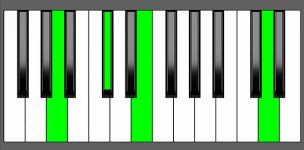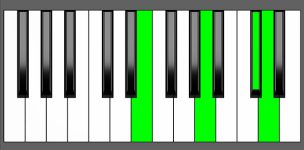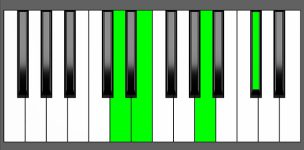Piano Diagram of A# add11 in Root Position

An A# add11 chord is an A# Major (A#, Cx, E#) with an extra 11th note (D#). It’s an added tone chord, meaning that it’s built by adding an extra interval to a triad. Keep reading to gain a deeper understanding of the music theory behind this chord.
Structure of A# add11
Notes |
|---|
| A#, Cx, E#, D# |
Intervals |
|---|
| R, 3, 5, 11 |
Playing Extended Chords on Piano
Extended chords are challenging to play in their entirety on the piano due to the high number of notes involved, or the wide intervals between them like in the case of add 11th chords. To simplify these chords, pianists may omit certain notes, typically the root or fifth, or divide the chord between both hands.
A# add11 Chord Inversions
A# add11 chord has a total of 3 inversions:
| Root Position: | A# | Cx | E# | D# |
| 1st Inversion: | Cx | E# | A# | D# |
| 2nd Inversion: | E# | A# | Cx | D# |
| 3rd Inversion: | D# | E# | A# | Cx |
Piano Keyboard Diagrams
Chord Inversions on Piano
Chord inversions are a crucial concept in music theory as they allow for a greater understanding of how chords are constructed and how they can be used in progressions.
However, it’s important to note that the diagrams depicting the sequence of notes in a chord inversion on a piano keyboard may not always translate to practical playing. This is because proper chord voicings involve distributing the notes of the chord across different octaves and positions on the keyboard, which may differ from the basic shape of the chord’s inversions.
Therefore, while chord inversion diagrams help understand the structure and sequence of notes in a chord, they may not always be the most efficient way to play the chord on a piano keyboard.
Music Theory and Harmony of A# add11
Building the A# add11 Chord: Different Approaches
Starting from the A# Major Scale:
To build an add11 chord, you can use the Major scale as a reference by combining a Root, a 3rd, a 5th, and an 11th.


Apply the formula R, 3, 5, 11 to get an A# add11 chord.
- Begin with the Root note, A#.
- Select the 3rd note, Cx.
- Add the 5th note, E#.
- Finally, include the 11th note, D#, which is a 4th note but an octave higher.
by Combining Intervals:
To build an add11 chord, one approach is to combine specific intervals, namely a major 3rd, a minor 3rd, and a minor 7th.
3 + m3 + m7 = add11 Chords
For example, to make the A# add11 chord, you can stack
- A#-Cx (major 3rd),
- Cx-E# (minor 3rd),
- and E#-D# (minor 7th) on top of each other.
How to Use A# add11 in a Chord Progression
Music theory classifies chords based on their harmonic function, which can be categorized as either tonic, subdominant, or dominant chords. The A# add11 chord, which can replace a regular A# major chord, can have any of these functions, depending on its context in a composition
However, the 11th note (D#) present in A# add11 may not always fit with the scale being used. This means that the chord can introduce a non-diatonic tone that does not belong to either the E# major or Cx minor scales. For this reason, the use of the A# add11 chord in these keys should be approached with caution to avoid dissonance or unintended clashes with the melody or the bass line. The use of non-diatonic chords should be intentional and targeted to specific musical effects.
The A# add11 chord can serve as a tonic chord that resolves the tension created by a preceding dominant chord, such as E#7. Alternatively, in a chord progression in the key of D# major, it can also act as a dominant chord. In both cases, it’s common to use the add11 chord in chromatic or diatonic modulation.
on Major Scales
The A# Maj7 or A#7 chords are primarily present in theoretical major keys. Therefore, it’s often more practical to refer to their enharmonic equivalent keys.
| Major Scales | I | ii | iii | IV | V | vi | vii |
|---|---|---|---|---|---|---|---|
| A# = Bb | Bb Maj7 ⇒ Bb add11 = A# add11 | C min7 | D min7 | Eb Maj7 | F7 | G min7 | Am7b5 |
| E# = F | F Maj7 | G min7 | A min7 | Bb Maj7 ⇒ Bb add11 = A# add11 | C7 | Dmin7 | Em7b5 |
| D# = Eb | EbMaj7 | F min7 | G min7 | Ab Maj7 | Bb7 ⇒ Bb add11 = A# add11 | C min7 | Dm7b5 |
- Tonic chord in Bb Major as Bb add11
- Non-diatonic Subdominant chord in F Major as Bb add11
- Dominant chord in Eb Major (less common) as Bb add11
on Natural minor Scales
As before, we will refer to the equivalent keys as the A# Maj7 or A#7 chords are present exclusively in theoretical minor keys.
| Minor Scales | i | ii | III | iv | v | VI | VII |
|---|---|---|---|---|---|---|---|
| Fx = G | G min7 | Am7b5 | Bb Maj7 ⇒ Bb add11 = A# add11 | C min7 | D min7 | Eb Maj7 | F7 |
| Cx = D | D min7 | Em7b5 | F Maj7 | G min7 | A min7 | Bb Maj7 ⇒ Bb add11 = A# add11 | C7 |
| B# = C | C min7 | Dm7b5 | Eb Maj7 | F min7 | G min7 | Ab Maj7 | Bb7 ⇒ Bb add11 = A# add11 |
- Mediant chord in G minor as Bb add11
- Non-diatonic Submediant chord in D minor as Bb add11
- Dominant chord in C minor (less common) as Bb add11
A# add11 in A# Major
A# add11 in E# Major (Non-Diatonic)
A# add11 in D# Major
A# add11 in Fx minor
A# add11 in Cx minor (Non-Diatonic)
A# add11 in B# minor
Alternative Names for A# add11
It’s important to note that A#11 and A# add11 are not the same chord. When building 11th chords, there are a minor 7th and a 9th in addition to the 11th interval.
- A# add11
- La# add11
- A# add(11)
- A# (add11)
- A# add11th



